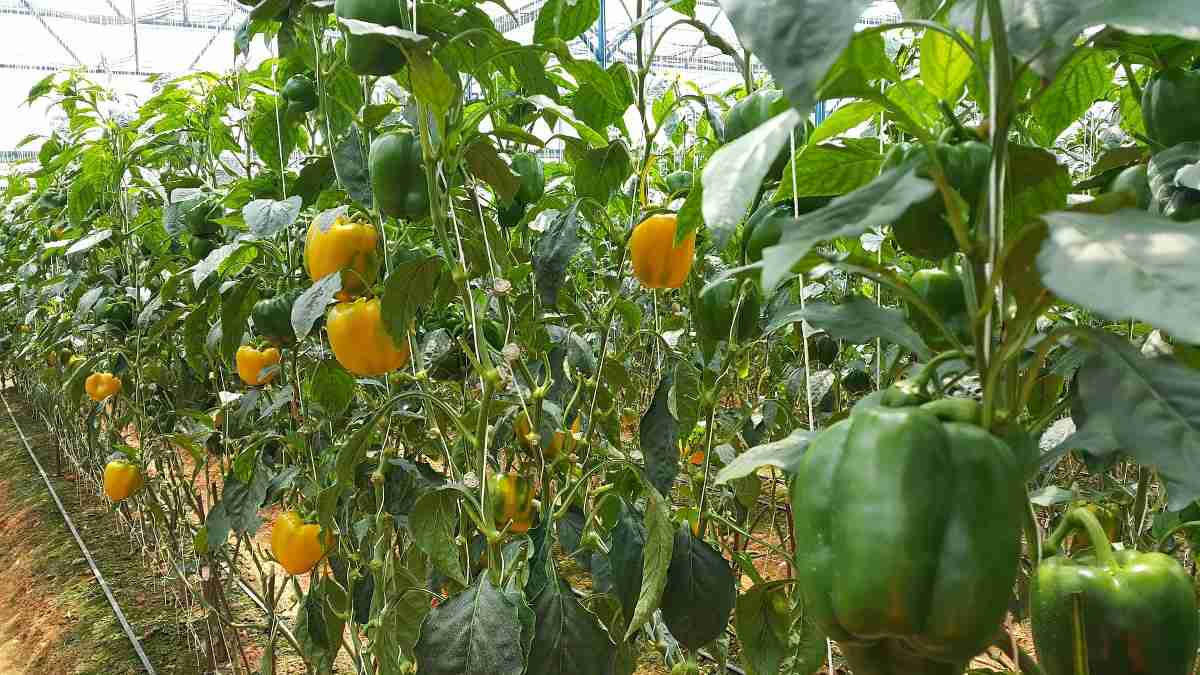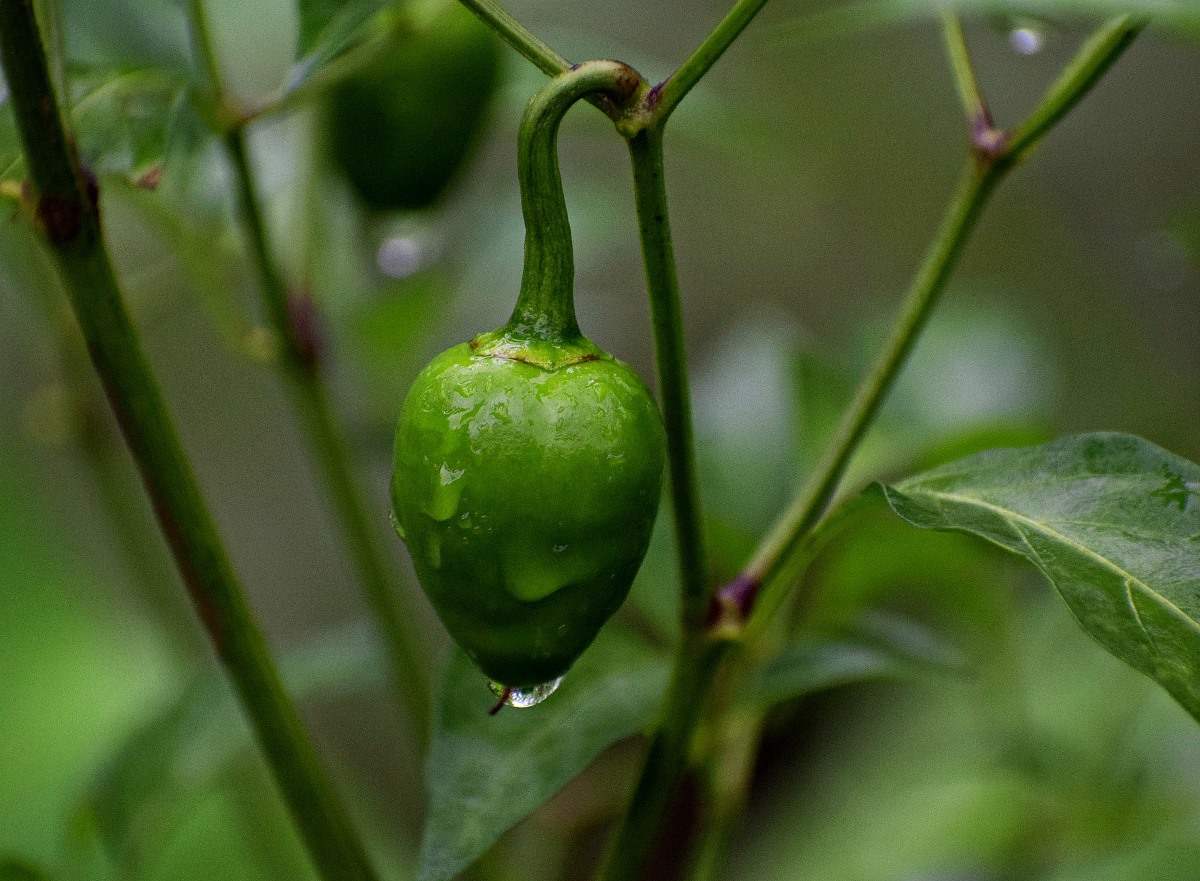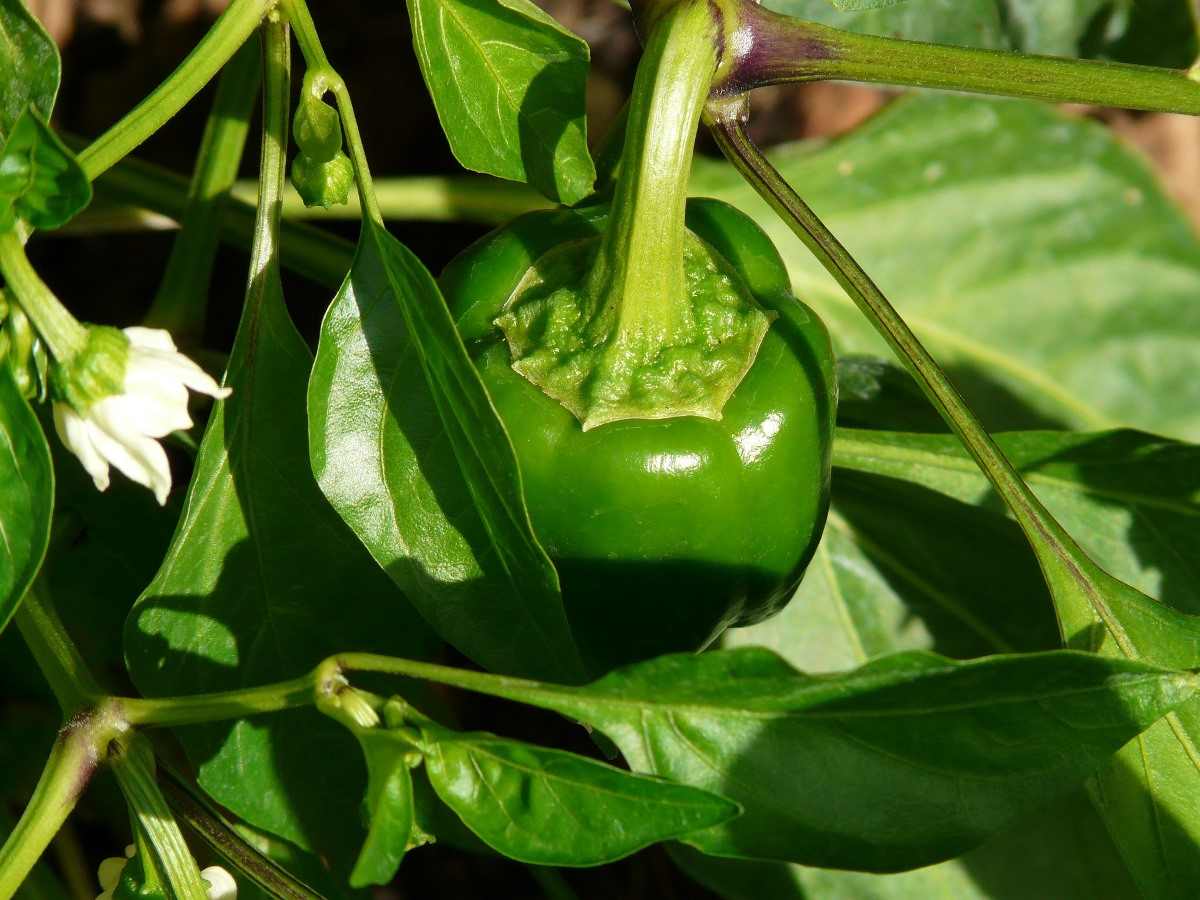Growing Capsicum in Greenhouse
Hello gardeners, today we are here with a new and different topic called growing capsicum in a greenhouse. Are you interested in growing capsicum in a greenhouse? Well, this article may help you to know about how to grow capsicum in a greenhouse. In this article, we also cover all the requirements for growing capsicum in a greenhouse.
Introduction to Growing Capsicum in Greenhouse
Capsicum is a species of the plant genus of Capsicum annuum and it is native to southern North America and even northern South America and also known as bell peppers. This type of species is the most common and extensively cultivated of the five domesticated capsicums. Bell Pepper is commonly referred to as capsicum it is a vegetable from a flowering plant native to America. This vegetable has many different names depending on the place and type such as chilli pepper, green pepper, red pepper; paprika, and bell pepper, etc. this plant is a perennial plant, which is being planted all around the world.
A Step By Step Guide for Growing Capsicum in Greenhouse
- How to Grow Hibiscus from Flower
- Plantation Ideas for Home Decoration: A Beginners Guide
- Flower Garden Designs and Layouts for Beginners
- Planting and Spacing Techniques in Papaya: A Beginner’s Guide
- Growing Gold: Essential Techniques for Planting Pineapples
- How to Make Kalanchoe Plant Bushy: Home Remedies and Solutions
- 11 Reasons Why Your Gardenia is Not Blooming: Home Remedies and Solutions
- Eco Elegance: The Guide to Designing a Drought-Tolerant Landscape
- Gardening on a Slope: Strategies for Hillside Landscaping
- Nourish and Flourish: Top Organic Mulches for Thriving House Plants
- Everything You Want to Know about Indian Mogra Flower: Discover Uses and Growing
- Green Thumb Success: Expert Tips for Cultivating Greenhouse Pumpkins All Year Round

The maximum height of the capsicum plant is different for different types or varieties, but the average height ranges from 30 to 90 cm in height. The leaves of the capsicum plant are oval and very bright green. The size of the capsicum leaf is proportional to the size of the fruit. It is considered that the plants producing small bell peppers or capsicum have very small leaves. The roots of the plant are very shallow and may extend up to 20 or 30 cm deep under the soil. The flowers of the capsicum plant are star-shaped and white. The fruit has different shapes like round, oblong, or even tapered and the skin of the fruit is very smooth and very shiny. They are available in many different colours like red, yellow, purple, and green. Generally, bell pepper or capsicum is very green under immature conditions but they turn red upon ripening. The newly introduced gardeners have fruits that are of different colours both under mature and immature conditions. The vegetable contains many white seeds in it, which give a spicy taste to it.
Advantages in Growing Capsicum in Greenhouse
It is always believed that protected gardening can be more advantageous than normal traditional farming methods due to very less or no dependence on external environmental conditions. Traditional planting of capsicum can yield only around 20-40 tons per hectare of land, which is comparatively very low to the yield which is generated or obtained from a greenhouse capsicum farm. Some advantages are outlined below:
- Higher yield and good quality produce
- Very good environmental protection
- Less damage from all the insects and pests
- Production is available all year round
- Harvest is possible nearly 2 to 3 times a year
Types/Varieties for Growing Capsicum in Greenhouse
Four types/varieties of bell pepper or capsicum are listed below:
- Red capsicum
The red capsicum is also known as the King of the Grill. These are highly versatile.
- Yellow capsicum
The yellow capsicums are very sweet and very high in nutritional content. This is the only reason that makes many people’s go-to Pepper. Yellow capsicum is very rich in vitamin C. They have a good pop of colour.
- Orange capsicum
The orange capsicum is a very good source of antioxidants, fibre, iron, and folic acid. They are even used as flavour to salads, dips, and sauces.
- Green capsicum
Green capsicum is very popular among all the capsicums. People always choose to pick them from all grocery marts or stores.
Suitable Soil for Growing Capsicum in Greenhouse
The soil for capsicum plants should be well-drained sandy loam soil. The soil should be highly porous and the salinity of the soil should not be more than 1 ms/cm. The pH of the soil should range from 6 to 7.
Suitable Climate for Growing Capsicum in Greenhouse
The optimum and ideal temperature required by the capsicum plant is 20 to 25˚C during the day time and 18 to 20˚C at the night time. The minimum humidity of the greenhouse should range around 65%. To control the temperature and humidity misters are needed to be started within the greenhouse every day for 3 to 4 minutes with half an hour interval.
Greenhouse Structure for Growing Capsicum
In India, depending on the climatic and weather condition of the region, different types of greenhouse structures can be used. The two commonly used structures are shade net house or greenhouse.
The shade net houses are built using granite stone pillars placed nearly 2 ft deep into the soil. The pillars of about 12 ft high and eight x 4 inch thick are utilized in the development. The ends of the pillars are sealed with rubber to avoid tearing the fabric. 50% HDPE white shade net is fixed and it supports another shade net (35%) either green or black. this extra shade net is required during the height summer season. The shade houses also are protected on all sides with a 40 mesh nylon net, which is UV stabilized.
Seedling for Growing Capsicum in Greenhouse
The number of seedlings required for 1 acre of land is nearly 16 to 20 thousand, and these can be grown from about 160-200 g of seeds of capsicum. The seeds are directly sown in pro-trays with 98 cavities. These need to be filled with sterilized cocopeat and seeds are sown to a depth of ½ cm. The trays are covered with plastic sheets until the germination of seeds occurs. One week after sowing the seeds the trays are moved to the greenhouse structure and watered lightly. These grown-up seedlings are then transplanted to the main area nearly after 30 or 35 days.
Transplanting, Pruning, and Training in Growing Capsicum in Greenhouse
The roots of the seedlings should be handled carefully and that they are transplanted into the holes of the polyethylene mulch film to a depth of 5 cm. The land or choose growing beds should be adequately watered before transplantation the seedlings. The raised bed can accommodate two rows of seedlings, the spacing between the rows is 60 cm and therefore the spacing between plants should be around 30 cm approximately. During the initial stages, the seedling is sprayed with a pesticide to stop any sucking pest infestation. The mulched growing beds are watered regularly employing a hosepipe to beat the warmth generated by the mulch film and also to assist the seedlings to establish well within the soil.
Each capsicum plant is trained to retain its 2 or 4 stems only. to take care of this, pruning the plants after 15-20 days of planting is important with an interval of seven days. After 4 months, pruning is completed once in 10 days.
Tips and Tricks for Growing Capsicum in Greenhouse to Get a Better and High-Quality Yield of Capsicum/Bell Pepper
There will be some special ways to handle the greenhouse capsicum for getting very high-quality yields and the tips and tricks for achieving these results are discussed below:
- A proper and very adequate supply of organic manure is to be given to the soil along with good microbial treatment.
- Care should be often taken to protect the greenhouse cover to minimize pest or insect attack.
- The greenhouse system should be facilitated by a double door system to maintain a protected environment.
- The seedling of the capsicum should be transplanted only after they attain certain growth.
- Regular pruning and thinning can help to increase the production of your plants.
- Irrigation and fertilizers should be adequately supplied so that your plants develop very fast and healthy.
- Cleaning your greenhouse and disinfecting it regularly can also prevent the occurrence of diseases in plants.
- The apical bud should be protected very carefully.
- Bio-control measures or bio-fertilizers are always suggested for greenhouse gardening.
Irrigation Requirement for Growing Capsicum in Greenhouse

For irrigating the capsicum plants within the greenhouse, a drip irrigation system is best suited. The drip line is laid before the mulching it with the film. one drip lateral at the middle of the growing bed with emitting points at 30 cm intervals is installed and therefore the discharge rate is approximately around 2 lit/ hr. Before irrigating the plants the soil should be tested for moisture content then irrigation is provided. Freshwater should be used for irrigation and through the summer season, water is supplied at the sides of the growing beds to catch up on the loss of water thanks to evaporation. The greenhouse should have the power of the water outlets to get rid of excess water from the world.
Mulching Capsicum Plants in the Greenhouse
Mulch film is made of black polyethylene is used for mulching the greenhouse area. The thickness of the film should be nearly 50-100 micron and 1.2 cm wide. Holes of 5 cm diameter with recommended spacing are created within the mulch sheet then they are laid on the growing beds. The sheet is anchored properly by securing the sides into the soil. This practice retains moisture within the soil, helps control weeds, and reduces the incidence of pests and diseases thereby leading to higher quality produce.
Fertigation Requirement for Growing Capsicum in Greenhouse
Fertigation is that the application of fertilizers through irrigation. NPK fertilizers within the ratio of 20: 25: 20 respectively, should tend as a basal dose to the plants. After three weeks of planting, 19 you look after NPK of two .5-4 g/ m² are given twice every week. Micronutrients should be supplied as and when the plants are required. The fertilizers required by the plants are collected and dissolved into sufficient water quantity and these should tend through irrigation generally within the early hours that’s 5-7 AM. The Fertigation systems should be cleaned thoroughly at regular intervals of time.
Common Pests and Diseases in Growing Capsicum in Greenhouse
The common and most affected pests of capsicum plants are aphids, thrips, whitefly, fruit borer, nematode, mites, etc.
The common and most affected diseases found on these plants are damping-off, powdery mildew, Cercospora leaf spot, Phytophthora, and other viral diseases.
To control the occurrence of diseases and pests, good cultural practices need to be adopted within the greenhouse. The debris within the plant surroundings should be cleared after harvest. Planting disease-free resistant varieties can help to keep the plants very healthy. Aside from these, properly chosen chemical pesticides or insecticides might be used for controlling the pests and diseases around the greenhouse.
Sometimes the fruit from the plant can have some physiological disorders like blossom-end rot, sunscald, fruit cracks, fruit splitting, fruit spots, misshapen fruit, and internal growth within the fruit. of these are often controlled by optimizing the growing environment within the absolute best way, watering the plants sufficiently, avoiding water-logging, etc.
How and When to Harvest Capsicum in Greenhouse
The capsicum should be picked in the early morning. The indication of fruit maturity is known by the very smooth and firm look of the fruit. They need to be removed from the plants with the stem attached to the fruit and collected into strong cloth bags. These bags aren’t placed on the bottom rather they’re hung from the shoulder of the picker. The fruit should be carefully removed so that the plant isn’t harmed. Each sort of capsicum plant produces different quantities of yield. The harvesting of green capsicum is completed after 55 to 60 days from transplanting. Similarly, yellow and red capsicum is also harvested after 70 to 75 and 80 to 90 days of transplanting respectively. The yellow and red capsicums should be picked only after proper colour development. The typical yield of the fruit from 1 acre of land is around 30-40 tons.
Commonly Asked Questions about Growing Capsicum in Greenhouse
In case if you miss this: Hydroponic Nutrient Chart For Vegetables.

Can I grow capsicum in a greenhouse?
To ensure a very good, reliable crop, capsicum needs a warm and sunny position outside, or they can be even grown in a greenhouse, grow frame, or similar covered structure. Although they can even be grown very well in well-prepared, rich, moisture-retentive soil, they usually plant better and more reliably if grown in containers.
How long does a capsicum plant take to grow?
Capsicums usually begin to flower within 1 to 2 months after planting and will take up to around 110 days from planting to their first harvest which then continues until cold weather or climate and reduces yield or frost stops growth.
How often should I water my capsicum plant?
As for watering, capsicums need moist soil but not overly wet soil. When seedlings are used watering can regulate the amount of water poured into your capsicum. Once they are established, water deeply up to every second day in hot and warm weather.
Why are my capsicums very small?
Some of the main important reasons that might have very small fruit are most likely due to your plant is not getting enough water, although their small size may also be caused by other external factors like your weather or climate or even the way you planted them.
Why my capsicum plant is leaves curling?
Water stress, especially from dry conditions or excessive heat, is that the primary explanation for leaf rolls on tomatoes and peppers, and it’s one among the only problems to reverse. An excessive amount of water or poorly drained soil can also end in leaf roll, but the leaves generally remain green.
How long do capsicum seeds take to germinate out?
It takes 14-18 days to germinate.
You need to plant seeds at a depth of ¼ inch and make sure the soil remains warm throughout the whole germination period.
What is the yield per acre of capsicum?
The average yield of capsicum per acre is nearly 30-40 tons. Capsicum fruits are very highly perishable and easily lose their water very rapidly due to their shrivelling, drying & softening of the fruit’s nature which accelerates even deterioration.